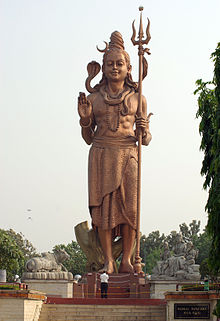- Danda nata
-
Danda Nata or Danda Jatra is one of the important dance festivals organized in different parts of South Orissa, particularly in the Ganjam District. The danda nata festival is being held in the month of Chaitra of every year.
The Danda Jatra is a kind of ritualistic festival. The total number of days for the festival is 13 or 21 days. The participants are known as the `Bhoktas`. All the `Bhoktas` lead a very pious life for al these days during the festival and they avoid eating meat, fish or cohabiting during this period.
Contents
Etymology
Danda has various meanings, but there are two main meanings of the word
- 1. Club, Rod, Pole, Stick, Staff, Sceptre
- 2. Punishment, Chastisement[1]
The term Nata comes from the word Natya, which gives many different denotations of music, dance and drama. The term Jatra means theatre.
Folktale of the origin of the word danda
Lord Ganesh was being taught a dance by his father, Lord Shiva. It was a religious dance called Tandava Naritya. In the process of learning the dance, Lord Shiva kicked the stage he was on, and made a sound that sounded like the word "Dan". Then a piece of brass material broke off the chain Lord Shiva wore around his ankle and fell on a percussion instrument known as Mardala. The brass material hitting the Mardala made a very loud "Da" noise. Those two sounds were put together to form the word Danda. Danda came to be associated with dance because of that episode.[1]
Danda Nata Ceremony
Danda Nata is an Indian dance festival that originated in the Boudh District of Orissa. Orissa is located in eastern India. Danda Nata is a form of a religious festival that has theatrical and dance components[1][2] . The dance is done mainly to worship Lord Shiva, the God of destruction of the Hindu mythology. There are other Gods and Goddesses that are worshipped by the spiritual dance also, such as Krishna Ganesh, Kali, and Durga amongst others. The low caste Hindus and the high caste, such as the Brahmins, all participated in the Danda Nata.[1][2] The dance along with the accompanying events is performed over the course of three months March, April, and May. Some events are performed in March – April, the month of Chaitra, and other events are performed in April – May, the month of Vaishakha.[1]
People commit self- inflicted wounds to worship Lord Shiva because the philosophy of ancient Hindu says that for a person to be great, one has to have self – control over one's body (Kaya), mind (Mana), and speech (Vakya).[1][3]
So in order to achieve greatness, a lot of punishments, Danda, to the individual must be undergone, so this event is known as Danda Nata.[1][3][4]
Dance component of the religious festival
Danda Nata consists of multiple dances. People start Danda by fasting, having a single meal a day made up of rice and dal, and worshipping their Lord before the actual dances occur.[4] Then males that belong to backward and scheduled castes perform the Parava dance. In the Parava dance, the Prabhakar, male acting as a male, and the Prabhakariani, a male acting as a female, begin the dance in multi – colored clothing. A piece of cloth is placed on the shoulders of dancers. The cloth is held with both hands and the dancers move the cloth backwards and forwards and side to side according to the rhythm of the dance. Then immediately following that dance the Hara – Parvati is performed.
After those dances are performed, a host of other dances are performed. The Fakir and Fakiriani, a group dance, is performed first. Then the Savara and Savarani are performed with the Chadeya and Chadouni dances being performed directly after. Then everyone gets involved in the festivities by performing a leela through songs and dances, which is based on a story from various Purans. After the leela, the Patarasaura and Patarasaurani perform their traditional dance. Lastly, the Binakar ends the events through dances and songs.
The roles of the dancers
The various dances of the Danda Nata have various themes behind them. Each of the roles in the dances sing a different tune. Some songs are based on historical stories, while others have a more comical approach. Some groups use a question/answer approach. The groups that use that approach have one role, male or female role, ask questions, while the other role give answers to those replies. Although the songs can be performed through multiple approaches, all the songs have the same style, folk and Odissi.
See also
References
- ^ a b c d e f g "Danda Nata". India Info Web. 2007. http://www.indiainfoweb.com/orissa/dances/danda-nata.html. Retrieved November 10, 2010.
- ^ a b "Odissi Dance". HareKrsna. 2005. http://www.harekrsna.com/sun/features/09-07/features785.htm. Retrieved November 10, 2010.
- ^ a b "Dances, Festivals, Recreation". http://boudh.nic.in/webpage/content_file/culture.htm. Retrieved November 10, 2010.
- ^ a b "Other States". India's National Newspaper (Orissa: The Hindu). March 28, 2010. http://www.hindu.com/2010/03/28/stories/2010032856820300.htm. Retrieved November 10, 2010.
Categories:- Festivals in India
- Oriya culture
Wikimedia Foundation. 2010.

